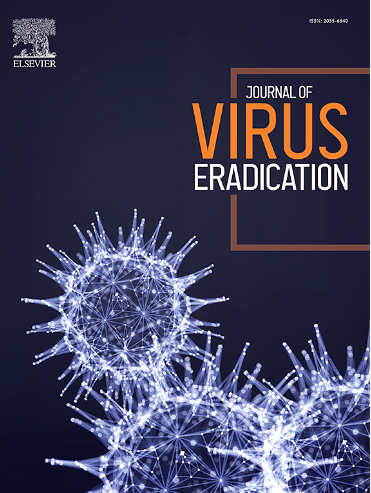2012-2023年智利治疗经验患者临床样本中HIV整合酶链转移抑制剂(insis)获得性耐药的流行情况
IF 2
4区 医学
Q2 IMMUNOLOGY
引用次数: 0
摘要
整合酶链转移抑制剂(iniss)广泛用于HIV治疗,但很少有大规模的研究在人群水平上检测获得性耐药(AR)。本研究评估了智利12年来急性呼吸道感染患者的患病率、模式和临床意义。方法分析2012年至2023年间确诊病毒学失败的抗逆转录病毒治疗个体和基于inst的治疗方案的5266个基因型序列。使用Stanford HIVdb算法对抗性相关突变进行分类。比较了大流行前(2012-2019年)和大流行后(2020-2023年)期间的耐药性趋势。结果第一代inis的AR发生率较高:雷替重力韦(28%)和韦替重力韦(27.7%)。多替格拉韦(8.3%)、比替格拉韦(8.3%)和卡替格拉韦(18.7%)的耐药水平较低。主要耐药突变为N155H(25.2%)、Q148 H/K/R(17.2%)和Y143R(14.3%)。值得注意的是,Q148 H/K/R突变总是与其他主要突变组合发现。观察到亚型特异性差异,F亚型(55.6%)的第一代耐药率高于B亚型(23.9%)。第一代insis大流行后耐药性显著增加(25%对31%,p < 0.05)。突变N155H虽然对DTG或BIC没有显著影响,但对CAB具有中等抗性。尽管在治疗方案中没有检测到CAB耐药性,但可能是由于交叉耐药途径。结论智利获得性药物耐药较高,尤其是第一代药物。这些发现强调了在全国范围内进行分子监测和治疗前基因分型的必要性,特别是在开始长效方案(如CAB-LA)之前。战略监测对于维持当前和下一代信息系统的效力至关重要。本文章由计算机程序翻译,如有差异,请以英文原文为准。
Prevalence of acquired resistance to HIV integrase strand transfer inhibitors (INSTIs) in clinical samples from treatment-experienced patients in Chile, 2012–2023
Background
Integrase strand transfer inhibitors (INSTIs) are widely used in HIV treatment, yet few large-scale studies have examined acquired resistance (AR) at the population level. This study assessed the prevalence, patterns, and clinical implications of AR to INSTIs in Chile over a 12-year period.
Methods
We analyzed 5266 genotypic sequences from ART-experienced individuals with confirmed virological failure and INSTI-based regimens between 2012 and 2023. Resistance-associated mutations were classified using the Stanford HIVdb algorithm. Resistance trends were compared between pre-pandemic (2012–2019) and post-pandemic (2020–2023) periods.
Results
High AR rates were observed for first-generation INSTIs: raltegravir (28 %) and elvitegravir (27.7 %). Lower resistance levels were found for dolutegravir (8.3 %), bictegravir (8.3 %), and cabotegravir (18.7 %). Major resistance mutations included N155H (25.2 %), Q148 H/K/R (17.2 %), and Y143R (14.3 %). Notably, Q148 H/K/R mutations were always found in combination with other major mutations. Subtype-specific differences were observed, with higher first-generation INSTI resistance in subtype F (55.6 %) than in subtype B (23.9 %). Post-pandemic resistance increased significantly for first-generation INSTIs (25 % vs. 31 %, p < 0.05). The mutation N155H, while not impacting DTG or BIC significantly, conferred intermediate resistance to CAB. CAB resistance was detected despite its absence in treatment protocols, likely due to cross-resistance pathways.
Conclusions
Acquired INSTIs resistance in Chile is high, especially for first-generation drugs. These findings highlight the need for nationwide molecular surveillance and pre-treatment genotyping, particularly before initiating long-acting regimens such as CAB-LA. Strategic monitoring will be critical to maintaining the efficacy of current and next-generation INSTIs.
求助全文
通过发布文献求助,成功后即可免费获取论文全文。
去求助
来源期刊

Journal of Virus Eradication
Medicine-Public Health, Environmental and Occupational Health
CiteScore
6.10
自引率
1.80%
发文量
28
审稿时长
39 weeks
期刊介绍:
The Journal of Virus Eradication aims to provide a specialist, open-access forum to publish work in the rapidly developing field of virus eradication. The Journal covers all human viruses, in the context of new therapeutic strategies, as well as societal eradication of viral infections with preventive interventions.
The Journal is aimed at the international community involved in the prevention and management of viral infections. It provides an academic forum for the publication of original research into viral reservoirs, viral persistence and virus eradication and ultimately development of cures.
The Journal not only publishes original research, but provides an opportunity for opinions, reviews, case studies and comments on the published literature. It focusses on evidence-based medicine as the major thrust in the successful management of viral infections.The Journal encompasses virological, immunological, epidemiological, modelling, pharmacological, pre-clinical and in vitro, as well as clinical, data including but not limited to drugs, immunotherapy and gene therapy. It is an important source of information on the development of vaccine programs and preventative measures aimed at virus eradication.
 求助内容:
求助内容: 应助结果提醒方式:
应助结果提醒方式:


